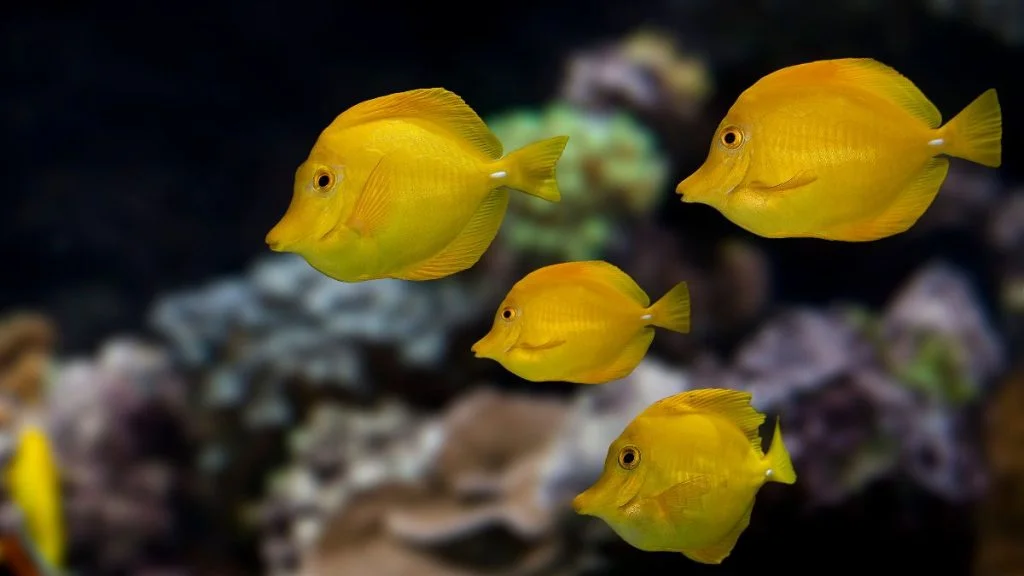Yellow is a beautiful color, and for many people, it represents positivity.
In the animal kingdom, however, we don’t always believe that. Yellow is uncommon amongst animals, and when we do see one, we tend to avoid it.
But while some yellow animals are certainly poisonous, not all of them are. Either way, they invite a lot of curiosity, mainly because of how they stand out.
Here’s a list of some of the world’s most stunning yellow animals—most are adorably cute, while some are better avoided.
List of Yellow Animals
1. American Goldfinch

- Scientific Name: Spinus Tristis
- Classification: Bird
- Size: 5.5 inches
- Habitat: Forest
The American Goldfinch is the first bright yellow animal on our list and is easily recognizable because of its color.
It hails from North America and migrates as the seasons change. The males tend to be brighter than the females and use that color advantage to attract the females.
The American Goldfinch is a granivore, and it was fashioned to pick and eat grains.
It also is comfortable around humans and has increased in number thanks to feeders. Goldfinches can be found in residential areas and open spaces.
2. American Yellow Warbler
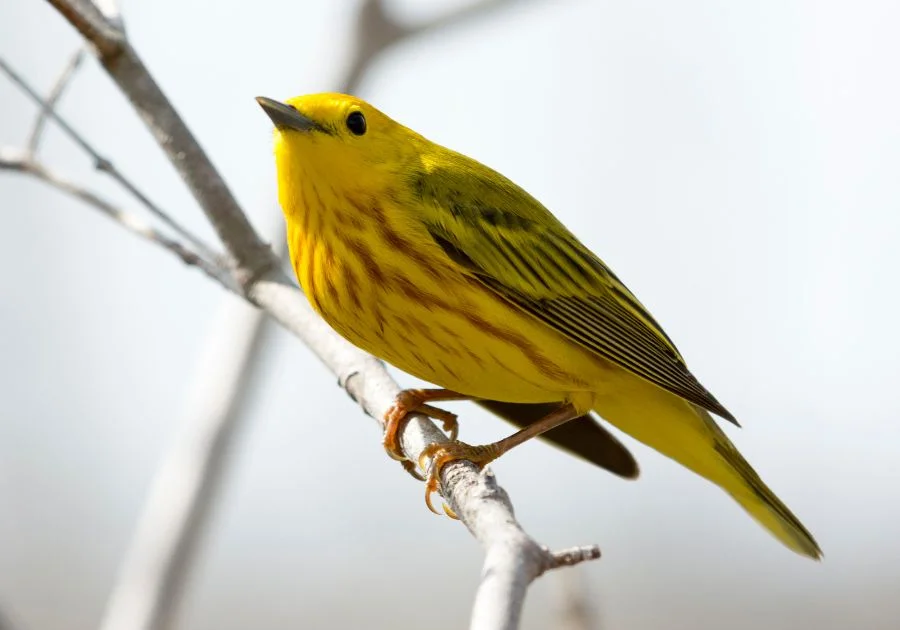
- Scientific Name: Setophaga petechia
- Classification: Bird
- Size: 7.1 inches
- Habitat: Forests
The Warbler is often cited as one of the prettiest birds, and its yellow feathers are the core aspects of its beauty.
It is highly widespread, from North America to the South. Like the Goldfinch, there’s a color difference between the male and the female, with the male being brighter.
The Warbler is an omnivore, and its diet consists of both insects and plants.
It lives close to humans and is considered safe, so though there has been a population decline in some areas, the Warbler is of least concern.
3. Clouded Sulphur
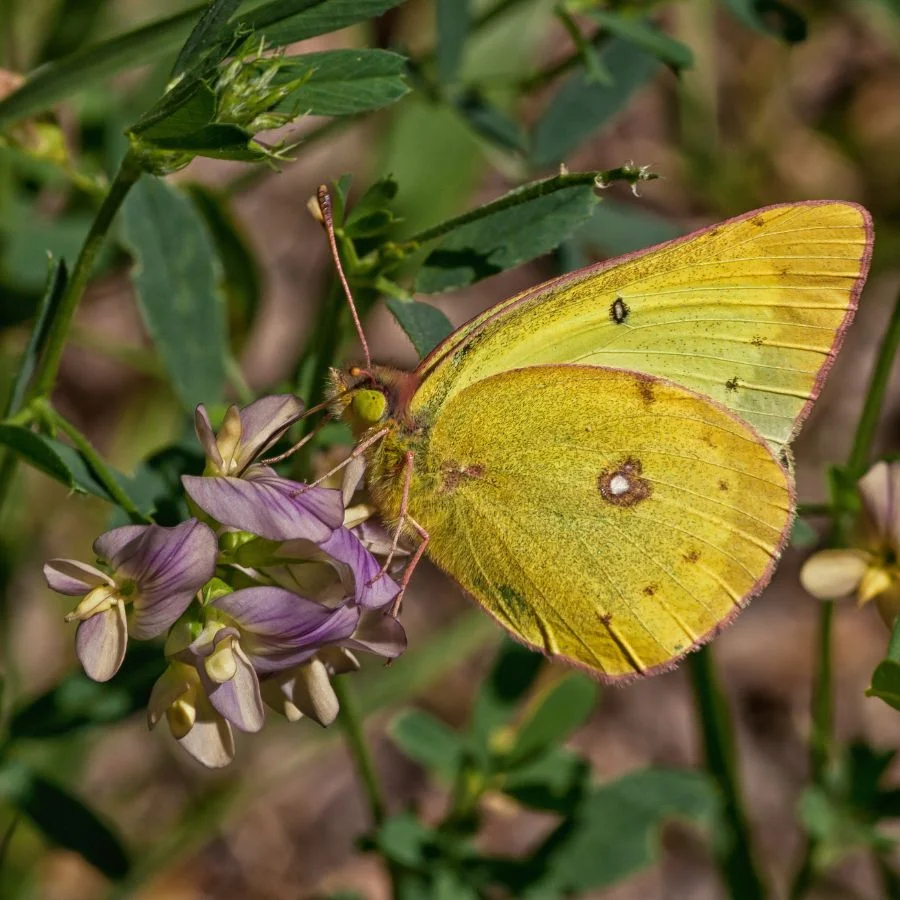
- Scientific Name: Colias philodice
- Classification: Insect
- Size: 2 inches
- Habitat: Fields, lawns, meadows
Also known as the Common Sulphur, this is a butterfly that can be seen in fields, lawns, meadows, and generally anywhere with plants.
It lives in the United States, as well as many other countries in North America. They migrate every year.
Clouded Sulphur got this name from the chemical compound sulfur because of its similar yellow color.
Males and females have little differences in color, but the females have dots on the wings while the males have borders.
4. Ghost Crab

- Scientific Name: Ocypodinae
- Classification: Malacostraca
- Size: 3 inches
- Habitat: Seashores
Crabs are not usually yellow, and this immediately distinguishes the Ghost Crab.
It also makes it easier for this crab to camouflage in the sand as the colors easily blend. The Ghost Crab uses this camouflage as a hunting strategy.
It preys on other crabs, sea turtle eggs, clams, etc. The name alludes to its nocturnal nature.
Ghost Crabs can also be prey, and they have ways of escaping predators. They’re fast, and once they get to the nearest burrow or the sea, good luck trying to catch them.
They can make different sounds, and the yellow color can change to match the surrounding.
5. Yellow Tang
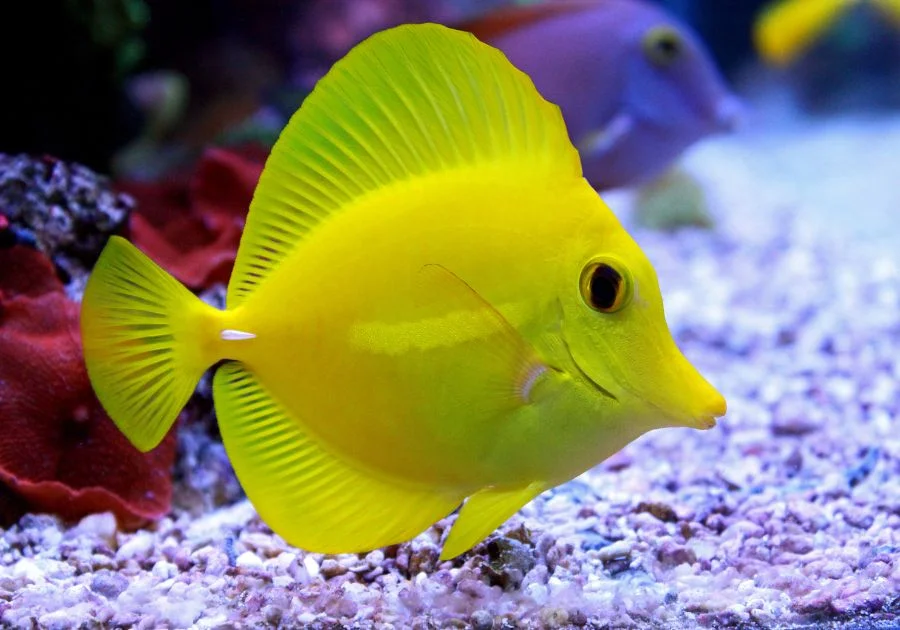
- Scientific Name: Zebrasoma flavescens
- Classification: Fish
- Size: 7.9 inches
- Habitat: Ocean
The Yellow Tang is a saltwater fish species that are usually found today in water aquariums.
It is named “Yellow Tang” because of its color and the spines found on the tail.
Those spines are specially reserved for predators, as the sea is dangerous for little fishes.
Another quality that protects the Yellow Tang is its ability to fade into the night.
Its diet is algae, and besides staying in aquariums, it is also on Hawaiian and Japanese beaches.
6. Asian Golden Weaver
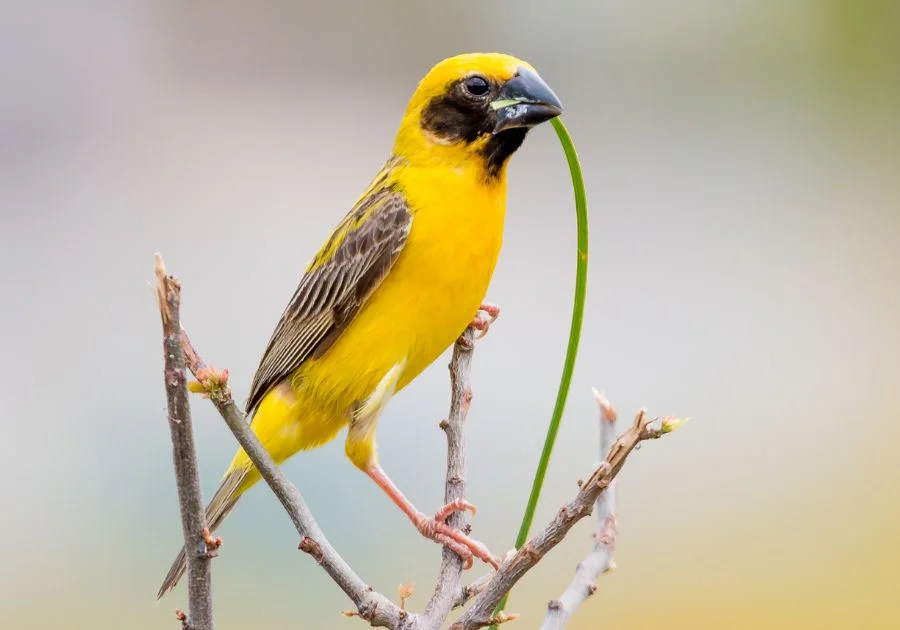
- Scientific Name: Ploceus hypoxanthus
- Classification: Bird
- Size: 8.5 inches
- Habitat: Grasslands, swamps
The Asian Golden Weaver is found only in Cambodia, Vietnam, Laos, Thailand, Myanmar, and Indonesia.
The yellow feathers earned it the “Golden” in its name, and this weaver got the feathers all over its body except for the face, tail, and beak.
Like other yellow birds, the Male Asian Golden Weaver is brighter than the female. The Male is also bigger.
The natural habitats of the Asian Golden Weaver are grasslands, swamps, and arable lands.
Its main diet is seeds, but it can eat insects too. Sadly, it is under threat due to habitat loss.
7. Banana Slug

- Scientific Name: Ariolimax
- Classification: Gastropod
- Size: 9 inches
- Habitat: Forests, rainforests
The Banana Slug deceitfully resembles a banana, and if it should stay close to the fruit, you may not tell the difference.
The Banana Slug is often colored yellow and has a black head, further making it banana-like. However, yellow is not its only color.
It can also be green, tan, brown, or white. The Banana’s slug color varies, depending on the environment.
This is a North American species, and it can be found on the grounds of forests and rainforests.
It is a detritivore, a term that regroups animals that eat dead organic matter both from animals and plants.
Banana slugs are prey to raccoons, garter snakes, geese, ducks, and salamanders.
8. Burmese Python
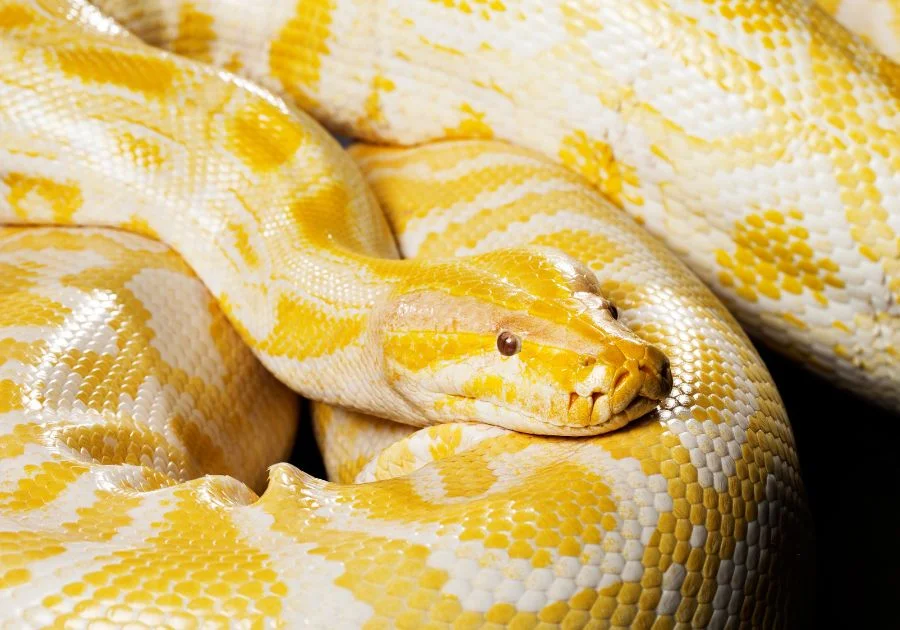
- Scientific Name: Python Bivittatus
- Classification: Reptile
- Size: 26 feet
- Habitat: Rainforests, aquatic habitats
The Burmese Python is from Southeast Asia, and it is regarded as one of the five largest snake species in the world.
The reptilian skin is often covered in yellow with black or white stripes on it.
At 200 pounds, the Burmese Python is sure to strike fear in the heart of many. It is one of the most dangerous yellow animals.
Once a subspecies of the Python molurus, it has since been recognized as a species of its own. It comes from Southeast Asia and loves being close to water.
Grasslands, marshes, woodlands, rocky foothills, and river valleys are some good habitats of the Burmese Python.
9. Climbing Mantella
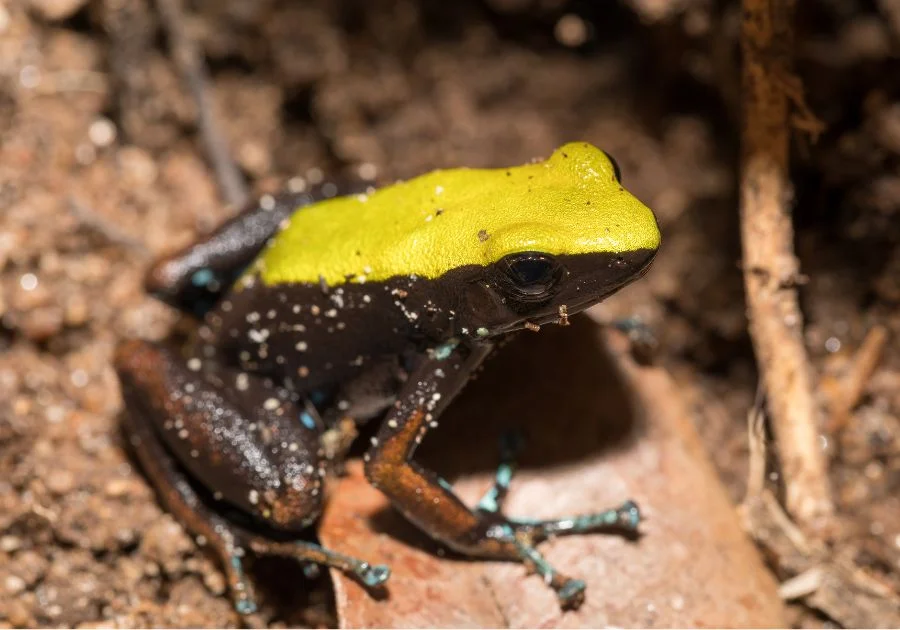
- Scientific Name: Mantella Laevigeta
- Classification: Amphibian
- Size: 1.1 inches
- Habitat: Tropical forests
The Climbing Mantella’s conservative status is least concern, but it isn’t widespread.
This frog can be found only in the forests of Madagascar, where its population is slowly declining due to habitat loss.
The Climbing Mantella lives on trees, and while it is poisonous, it is not considered harmful to humans.
The poison detracts predators that may want to grab it into the mouth and is a defense mechanism.
In addition, the Climbing Mantella jumps fast and is agile, making it easy to escape certain predators.
10. Goldenrod Crab Spider
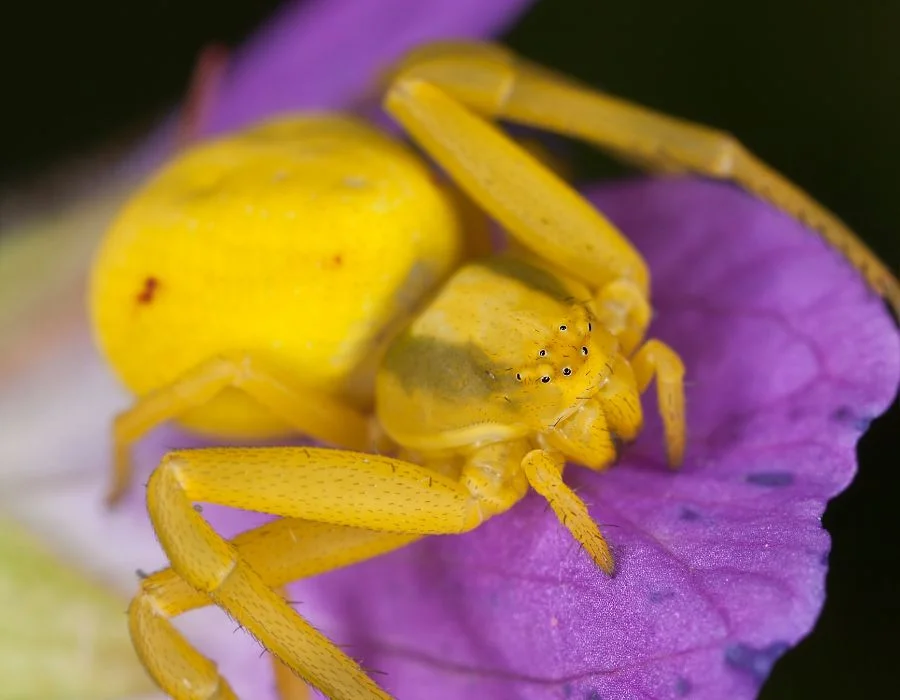
- Scientific Name: Misumena vatia
- Classification: Arachnid
- Size: 0.35 inches
- Habitat: Forests
Normal spiders can be creepy to a lot of us. Give it a yellow color and it is sure to halt you in your tracks.
The Goldenrod Crab Spider looks dangerous, but in reality, it is harmless to humans.
The males tend to be the only yellow ones, while the females are white. The females are bigger.
This species is also known as Misumena vatia and the flower (crab) spider.
It was named the Goldenrod Crab Spider because of its ability to walk sideways, forward, and backward.
Goldenrod can go through color changes, especially if it eats colored prey.
11. Land Iguana
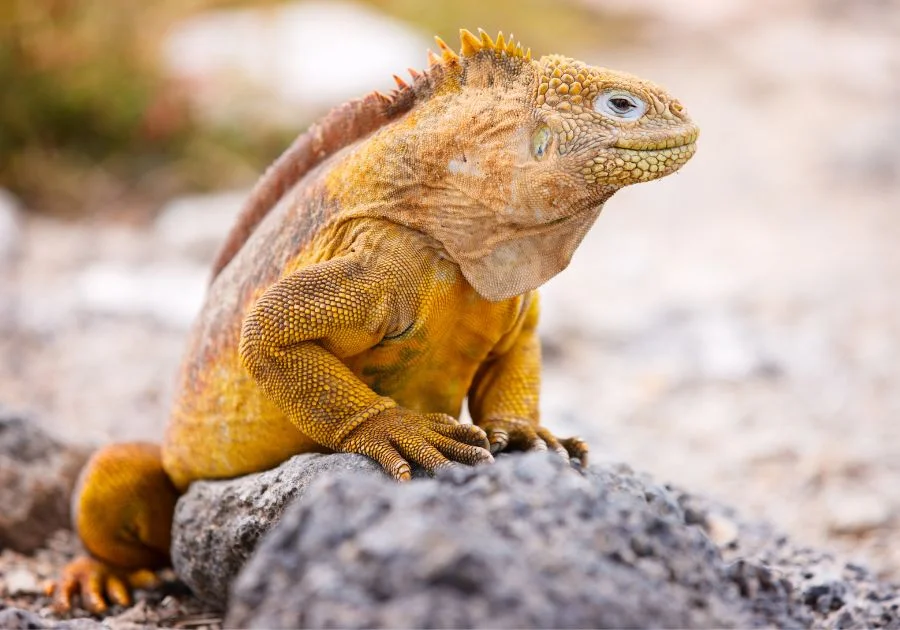
- Scientific Name: Conolophus subcristatus
- Classification: Reptile
- Size: 3 to 5 feet
- Habitat: Lowlands
The Land Iguana is a big lizard species with an incredible lifespan, getting up to 60 years.
It lives solely in Galapagos Islands, where it feeds on the cactus for the most part. Due to its origin, the Land Iguana is also called the Galapagos Land Iguana.
Yellow isn’t the only color of the Land Iguana, but it is a predominant one. It has a brownish-red surface and a yellowish-orange color underneath.
The Land Iguana is cold-blooded like every other reptile species and is known to have a good relationship with birds.
12. Panamanian Golden Frog
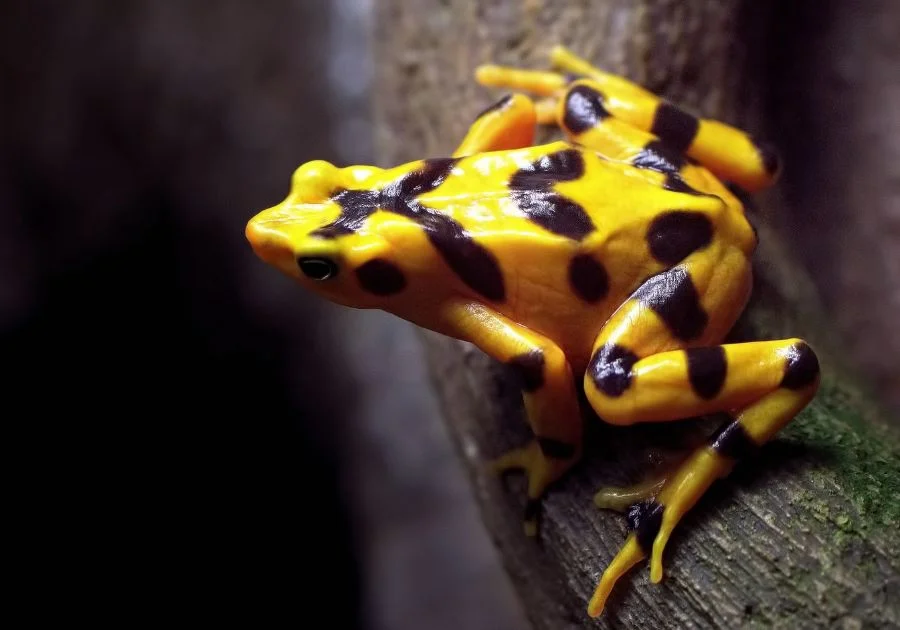
- Scientific Name: Atelopus Zeteki
- Classification: Amphibian
- Size: 2 inches
- Habitat: Rainforests
The Panamanian Golden Frog is a native of Panama, which is the one place this frog can be found.
It is currently listed as critically endangered, and there’s a possibility of it no longer being in the wild.
The only ones left are those preserved in captivity to prevent them from going extinct completely.
Regardless of its status, the Panamanian Golden Frog is revered and considered a very beautiful frog.
It is even a national symbol in Panama, and while it bears the name “Golden Frog,” it is considered a true toad.
The species is known to use sound for many purposes, including mating.
13. Yellow Seahorse
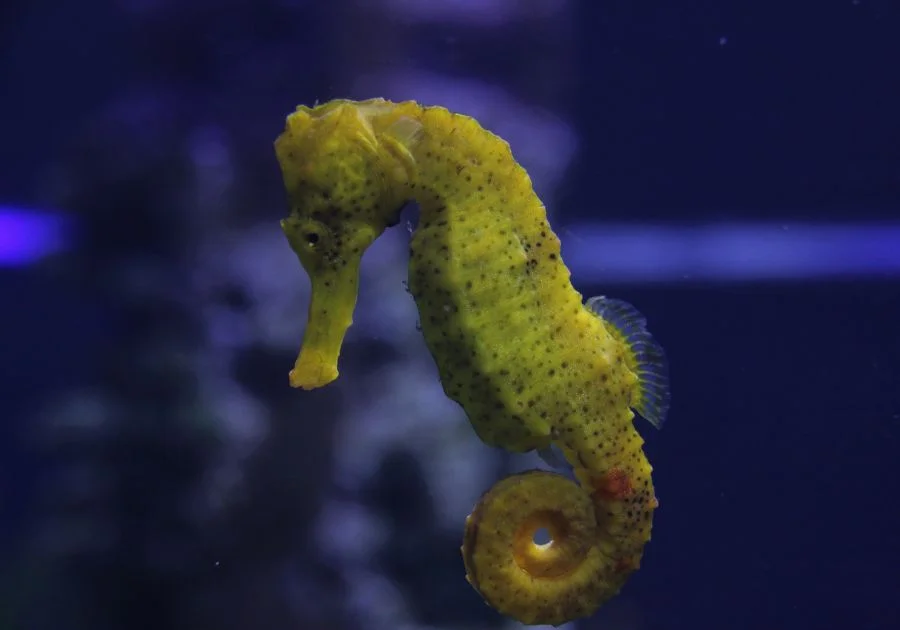
- Scientific Name: Hippocampus kuda
- Classification: Actinopterygii
- Size: 12 inches
- Habitat: Indo-Pacific
Also known as the Hippocampus kuda, sea pony, or common seahorse, the yellow seahorse is an underwater species with no scales. In the place of scales, it has layers of skin covers.
The Yellow Common Seahorse is a sneaky predator that sucks its prey into its tube-shaped mouth.
The gender disparity differs in the Yellow Common Seahorse as the male gets pregnant, not the female.
Eggs are fertilized in the males, and they carry them in the pouches. The Yellow Common Seahorse is monogamous.
14. Apple Snail

- Scientific Name: Ampullaridae
- Classification: Gastropod
- Size: 5 inches
- Habitat: Forests
The Apple is so named because of its shell that is shaped like an apple…a yellow apple.
The entire body of the Apple Snail is yellow, with the shell taking on a darker shade.
It is also known as Ampullaridae, and one special thing about this specie is that it has both a gill and a lung.
The Apple snail is either male or female, and it is one of the few snails that require both sexes for breeding.
The Apple snail is native to South America, Central America, the Southern United States, and the West Indies.
Some can also be found in Africa and Asia. It adapts well to tropical regions.
15. Canary

- Scientific Name: Serinus Carania
- Classification: Bird
- Size: 3 to 4 inches
- Habitat: Orchards and forests
The Canary is one of the most popular birds, and there are two forms of it: the domestic canary and the wild canary.
Canaries were first domesticated in the 17th century and have since become sought-after pet birds because of their singing quality.
The canaries come in many colors; yellow is one of the most common.
As domestic pets, they are usually categorized into three different groups: the Color-bred canaries, type canaries, and the song canaries.
In the wild, they live in orchards and forests.
16. Electric Yellow Cichlid

- Scientific Name: Labidochromis caerulus
- Classification: Fish
- Size: 3.2 inches
- Habitat: Lake Malawi
The Electric Yellow Cichlid can be found only in Lake Malawi, and as such, it is considered rare.
It is also known as the Labidochromis caerulus (its scientific name), the lemon yellow lab, the blue streak hap, and the yellow prince.
Though endemic to Lake Malawi, it is kept as a pet by many people.
The Electric Yellow Cichlid as a pet should be kept in a specialist cichlid aquarium and not with other freshwater species.
The Electric Yellow Cichlid is a maternal mouthbrooder, a term given to species that fertilize their eggs in the mouth.
17. Eurasian Golden Oriole
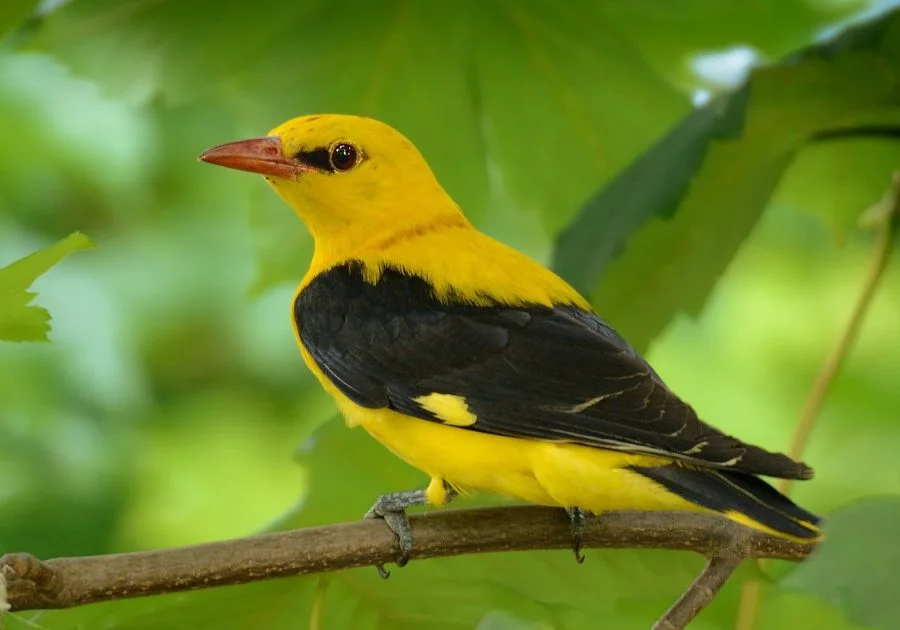
- Scientific Name: Oriolus Oriolus
- Classification: Bird
- Size: 18.5 inches
- Habitat: Forests
The Eurasian Golden Oriole lives in forests and can be found in places like western Europe, China, and Africa.
The Eurasian Golden Oriole is known for migration, especially at night—though during spring, it may travel during the day.
Forest isn’t the only habitat of this bird. It also inhabits orchards, large gardens, and plantations.
The forests vary too. The Eurasian Golden Oriole lives in broadleaf forests, continuous forests, and coniferous forests.
18. Eyelash Viper
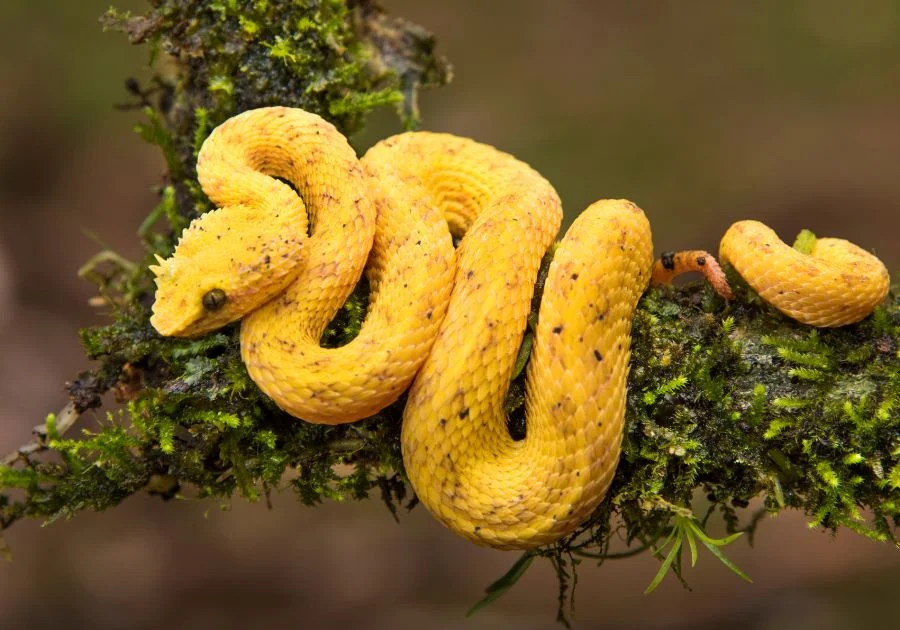
- Scientific Name: Bothriechis schlegelii
- Classification: Reptile
- Size: 32 inches
- Habitat: Densely wooded sea-level forests
The Eyelash Viper is a unique form of viper because of the standing eyelashes.
It is colored yellow, another quality that sets it apart from other vipers.
As attractive as it might look, the Eyelash Viper is not a snake you should approach without caution.
It has a high level of venom that can be fatal to humans if not treated.
The Eyelash Viper is also known as the Eyelash Pit Viper, Eyelash Palm Viper, Eyelash Palm-Pitviper, Eyelash Snake, etc.
It can be found in humid habitats like ravines. This snake is not known to be aggressive and will only attack when threatened.
19. Golden Poison Frog
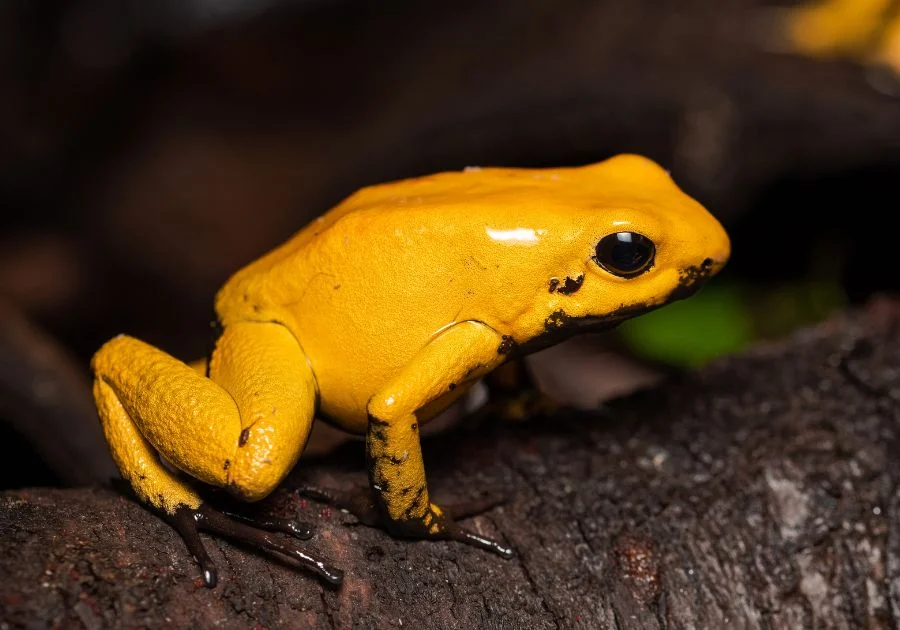
- Scientific Name: Phyllobates terribilis
- Classification: Amphibian
- Size: 2 inches
- Habitat: Rainforest
Also known as the Golden Dart Frog and the Golden Poison Arrow Frog, this species can be found only in the Colombian rainforests.
This is among the dangerous animals that are yellow—for the Golden Poison Frog, a bright yellow signifies more danger, not positivity.
It might be small, but it is highly toxic. It is considered the most poisonous frog in the world and one of the most poisonous animals in general.
The Golden Poison Frog is currently endangered due to habitat loss. The high level is an advantage to it as the adult individual hardly has any predators.
It is also a hunter on its own, with insects as prey.
20. Fire Salamander
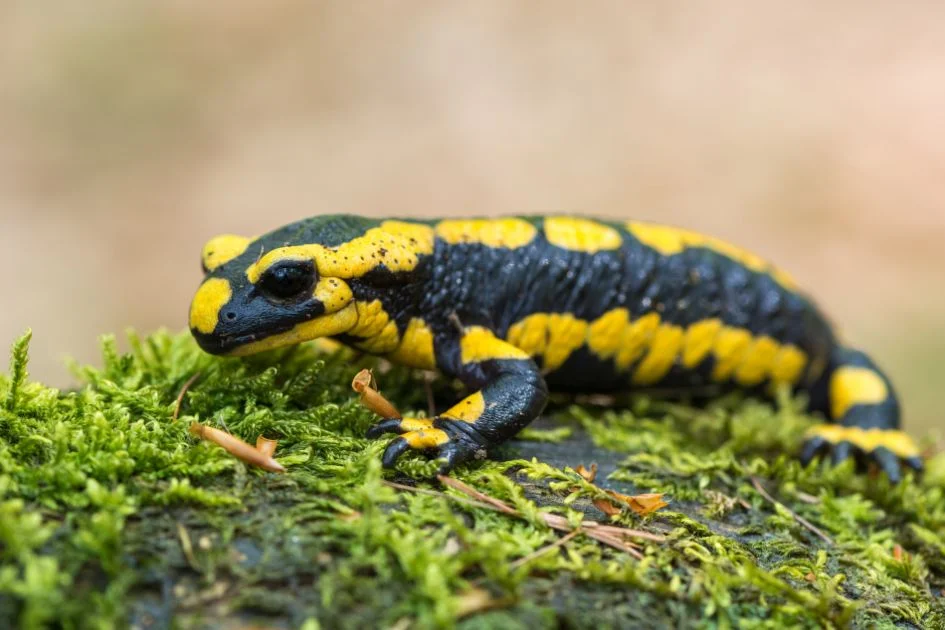
- Scientific Name: Salamandra salamandra
- Classification: Amphibian
- Size: 15 to 25 cm
- Habitat: Forests
The Fire Salamander lives in Europe, and it is one of the biggest salamanders on the continent. It is more common in the hilly parts of Europe and inhabits forests.
It also likes having a pool in its habitat where it can bathe. The Fire Salamander is often nocturnal but can be seen during the day when it rains.
This amphibian is a carnivore that feeds on insects, earthworms, slugs, and frogs, among others.
21. 22-Spot Ladybird
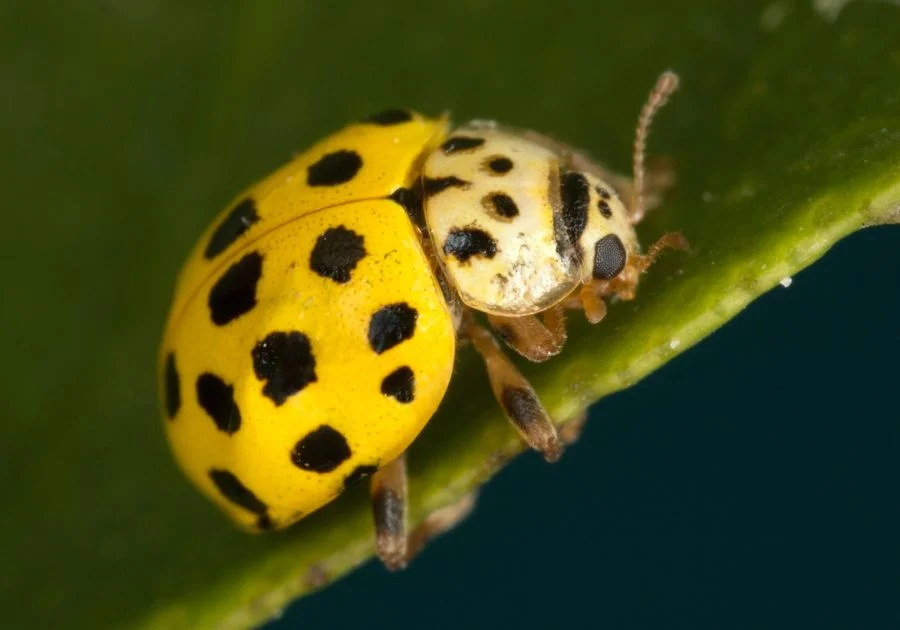
- Scientific Name: Psyllobora vigintiduopunctata
- Classification: Insect
- Size: 0.2 inches
- Habitat: Forests
The 22-Spot Ladybird is recognized by the number of spots its name says it has.
The spots are usually black, and the rest of its body is colored yellow.
It lives in forests, more specifically the European and North American own. It is also called the Psyllobora 22-Punctata.
This insect feeds on mildew, and besides forests, it inhabits grasslands, woodland edges, towns, and gardens.
It has a lifecycle that goes from egg to larvae to pupa down to the adult. The lifecycle is similar to that of a butterfly.
22. West Coast Sea Nettle
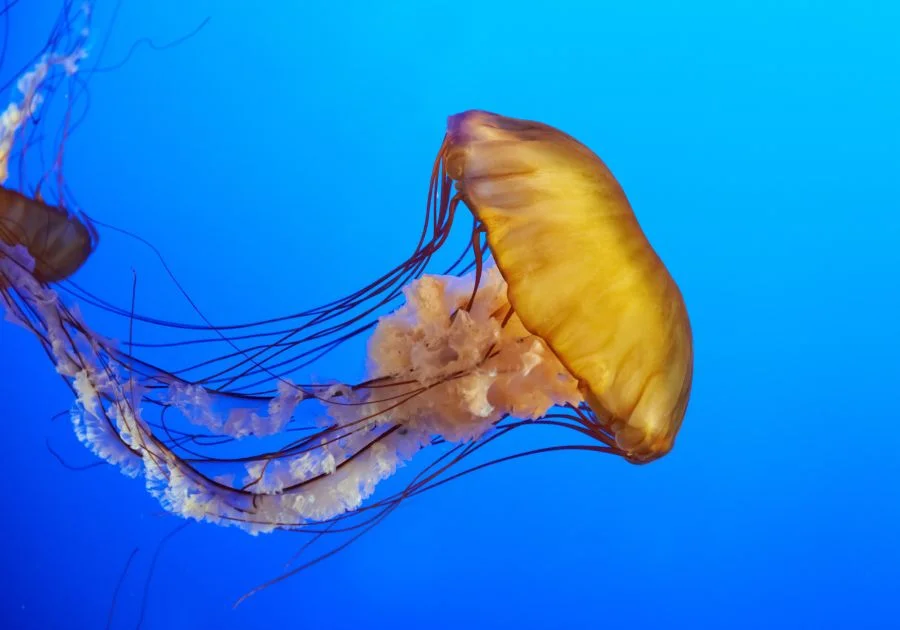
- Scientific Name: Chrysaora fuscescens
- Classification: Scyphozoa
- Size: 3 feet
- Habitat: Pacific Ocean
At a size of 3 feet, the West Coast Sea Nettle is one of the largest and longest sea creatures.
Its habitat is the Pacific Ocean, and it is known for its long tentacles, alongside its yellow color. The tentacles are both defensive and offensive weapons.
It uses it to hunt prey, and it emits toxins to keep predators away. You can’t mess with the West Coast Sea Nettle folks.
The Sea Nettles stings, too, though it isn’t fatal to a human.
While many are left in the open sea, quite a good number are held in captivity and displayed in public aquariums. They are easy to take care of.
23. Wasp
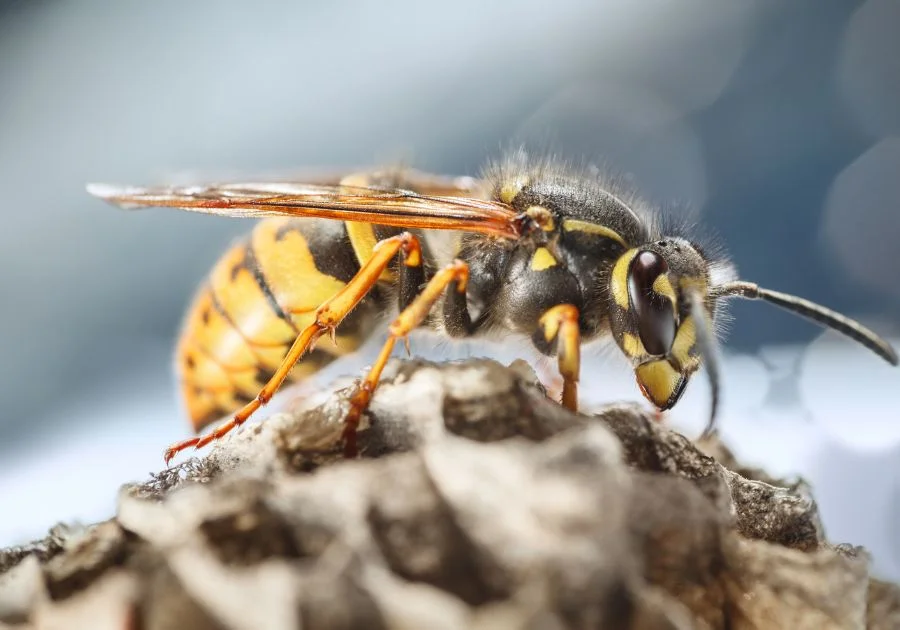
- Scientific Name: Vespula
- Classification: Insect
- Size: 0.47 inch
- Habitat: Forest, meadows
The Wasp isn’t as dangerous as a viper or a poison frog, but it isn’t a favorite of humans either. Its bite is painful, and for that reason, people either avoid it or kill it.
However, the wasp doesn’t exist to torment humans. It plays an important role in the ecosystem by pollinating plants.
It also takes care of pests, thereby keeping plants safe. Just don’t let it get close to you.
The preferred habitats of the wasp are forests and meadows. The wasp can be a predator, prey, and even a parasite.
24. Yellow Garden Spider

- Scientific name (genus): Argiope aurantia
- Classification: Arachnida
- Size: 0.75 to 1.1 inches
- Habitat: Near open fields, vegetation
Yellow Garden Spiders are often found in the United States, Canada, Mexico, and Central America.
Like other arachnids, they spin webs, but theirs is in a circular motion.
The female Garden Spider has a brighter color than the male, which is the reverse of what we’ve seen with many other animals on this list.
The Yellow Garden Spider releases venom, which isn’t harmful to humans but spells death for insects it considers prey.
Flies, bees, and other insects that unfortunately get caught in the web are immobilized using venom. Yellow Garden Spiders also use webs to woo and mate.
25. Yellow Anaconda
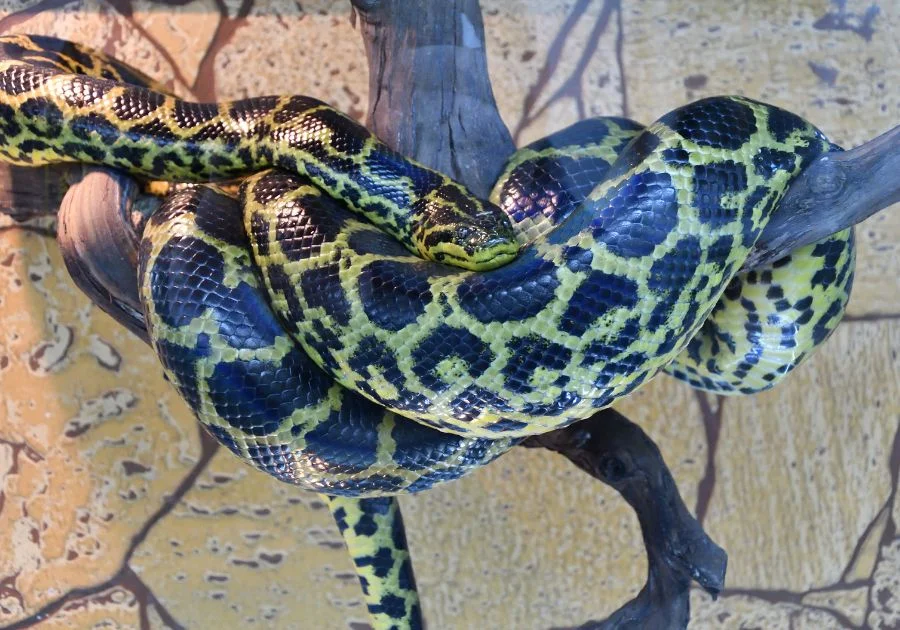
- Scientific Name: Eunectes Notaeus
- Classification: Reptile
- Size: 13 feet
- Habitat: Banks of slow-moving rivers
The general populace is scared of anacondas, and the 1997 horror thriller Anaconda increased the fear.
It is justified, though, even with the Yellow Anaconda. It is one of the largest snakes in the world, so the movie wasn’t exaggerating when it showed a powerful anaconda haunting people.
The Yellow Anaconda stays close to banks of slow-moving waters, especially in South America.
Like pythons, it produces no venoms. It captures its prey by constriction.
26. Swallow-tailed Moth
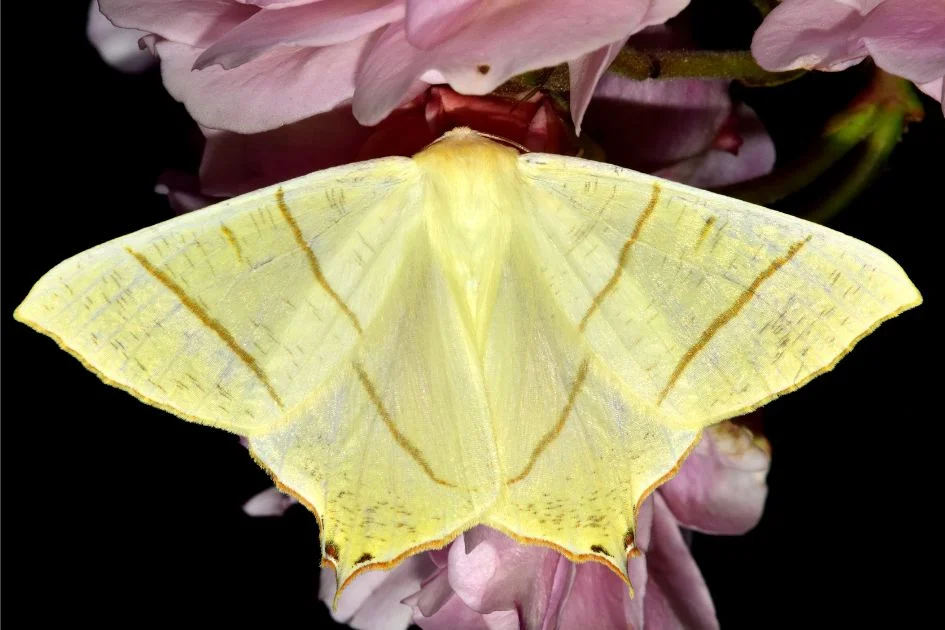
- Scientific Name: Ourapteryx sambicaria
- Classification: Moth
- Size: 62mm
- Habitat: Woodland, scrubs, gardens
Like other moths, the Swallow-Tailed Moth looks a lot like a butterfly, and its major colors are white and yellow.
It is a nocturnal insect and would often fly close to where light is.
It is often found around Europe and the Middle East. The Swallow-tailed Moth also has a life cycle like a butterfly.
The preferred habitats of this species of Moth are woodlands, scrubs, parks, gardens, and hedgerows.
27. Cockatiel

- Scientific Name: Nymphicus Hollandicus
- Classification: Birds
- Size: 30 to 33 cm
- Habitat: Arid, semi-arid areas
Also called the weiro bird or quarrion, the cockatiel is found only in Australia.
It is a popular household pet, second only to the budgerigar amongst caged birds. It makes a good companion as well.
When it isn’t a household pet, the Cockatiel is a nomad, finding the right spot where food is abundant.
lt is a nonpredatory bird and a herbivore, and only farmers get affected by the bird’s dietary needs because it picks at crops without reserve.
The Cockatiel is very vocal too.
28. Sun Conure
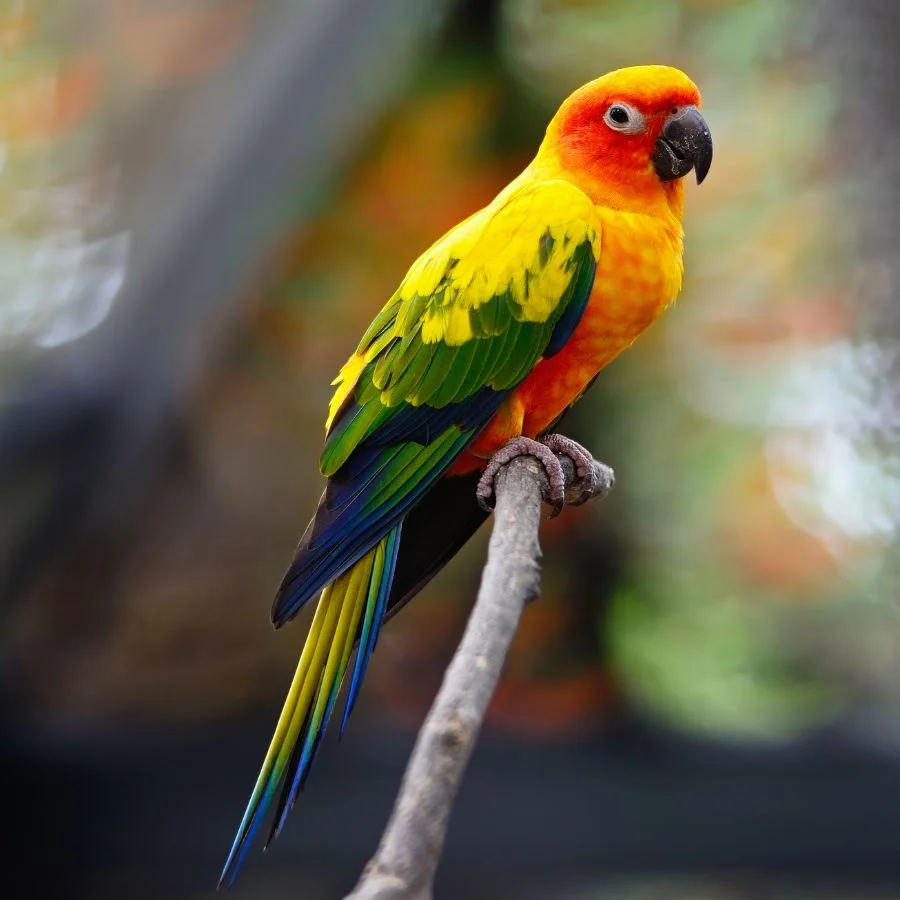
- Scientific Name: Aratinga solstitialis
- Classification: Bird
- Size: 12 inches
- Habitat: Tropical
The sun conure also goes by the name sun parakeet, and it is a parrot found in northeastern South America.
The sun conure is an endangered species currently due to habitat loss, hunting, and exotic pet trade.
With a lifespan of 30 years, however, the population can still get back up.
The Sun conure is a social bird; it isn’t uncommon to see it flying in large flocks of 15 and 30 individuals.
Loneliness is not an option for this species, and when left alone, it will call out in a loud voice for others to hear. It feeds on fruits, flowers, berries, seeds, and nuts.
29. Butterflyfish

- Scientific name (Family): Chaetodontidae
- Classification: Fish
- Size: 5 to 9 inches
- Habitat: Reefs
The Butterflyfish usually live on the reefs of the Atlantic, Indian, and Pacific oceans.
It is considered endangered due to the destruction of coral reefs but has a good chance of surviving with over 100 species around.
It is omnivorous, with a diet that consists of plankton, small invertebrates, and plant matter.
While the main colors are yellow and white, the Butterflyfish has a black spot on its back to confuse predators.
30. Bumblebee

- Scientific name (genus): Bombus
- Classification: Insect
- Size: 0.4 to 0.9 inches
- Habitat: Northern Hemisphere
Bumblebees are found mainly in the Northern Hemisphere.
Besides there, they can also be located in South America, along with countries like New Zealand and Tanzania.
They are important to humans because they pollinate flowers, so although they don’t produce honey like honeybees, they play a good role.
Female bumblebees are more likely to sting, but only when they feel threatened.
Bumblebees and honeybees have a similar social structure. They live in colonies with a queen.
They get their colonies when the queen attacks and conquers another colony, then the workers take care of the eggs she lay.
Final Thoughts
Animals that are yellow have their share of strengths, and as we’ve seen, not all of them are dangerous.
Some of them are best avoided, while others can even make good household pets.
There are many different types of yellow animals, from mammals to insects.
They all have what they contribute to nature besides their beautiful colors.
Check out these interesting articles:
